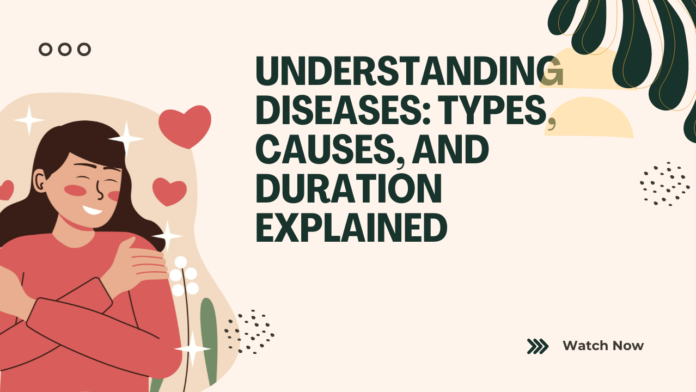Define disease
A disease is an abnormal condition that negatively affects the structure or function of all or part of an organism. it affects any part of any living being such as man, animal or plant. And usually the form of the symbol appears. It would not have been an immediate external injury. A disease may be caused not only by internal dysfunctions, Rather it may be caused by external factors such as pathogens also .Here we will discuss about human diseases. Diseases degenerate a person not only physically but also mentally.
If we talk about internal disorders of the immune system, it would not be wrong to say that It can cause various diseases. including various forms of immunodeficiency, hypersensitivity, allergies, and autoimmune disorders.
In humans disease is often used more broadly to refer to any condition that causes pain, dysfunction, distress, social problems, or death to the person affected, or similar problems for those in contact with the person. In this broader sense, it sometimes includes injuries, disabilities, disorders, syndromes, infections, isolated symptoms, deviant behaviors, and atypical variations of structure and function, while in other contexts and for other purposes these may be considered distinguishable categories.
What are the 4 categories of disease
There are four main categories of disease:
infectious diseases, deficiency diseases, hereditary diseases (including both genetic and non-genetic hereditary diseases), and physiological diseases.
1.infectious diseases
Bacteria, viruses, fungi or parasites are causes of infectious diseases. These organisms may live in or on our bodies. Some organisms may cause diseases for us and some can be helpful, And some are useless. Some infectious diseases can be passed from person to person, broadcasted by insects or other animals. you may get others by consuming contaminated food or water or being exposed to organisms in the environment. Its symptoms vary depending on the body. Often include fever and fatigue. Its effects are also according to the body. Some infections can be treated with home remedies, but some infections may require hospitalization. And some diseases are controlled by vaccines, such as chicken pox and measles.
Each infectious disease has its own distinct signs and symptoms. However, many infectious diseases shared by common general signs and symptoms, such as:
- Elevated Temperature
- Loose motion
- Tiredness
- fever
- Persistent Cough
2.deficiency diseases
Deficiency diseases are one of the most common. But it is mostly ignored worldwide. deficiency diseases are caused by intake of essential vitamins, poor minerals and other organic elements. Unfortunately, the lack of proper awareness and healthy diet also lead to the deficiency of these important components deficiencies in vitamin D, vitamin B12, and vitamin B9 are included in deficiency diseases.
Reports state that nearly 92% of Americans are suffering from vitamin deficiency. In India, approximately 75% of Indians are suffering from vitamin deficiencies.
Approximately 80% Indians suffer from a deficiency of vitamin D, followed by vitamin B12 (21.02%) and B9 (15.06%). Moreover, 84% of pregnant women are deficient in vitamin D.
When the body does not receive enough essential organic components like vitamins, minerals, proteins and carbohydrates. it cannot perform certain functions like average cell growth, division and stability. Due to a lack of essential organic components, deficiency diseases occur.
Deficiency diseases are in different types like as
- Vitamin Deficiency Diseases
- Mineral Deficiency Diseases
- Protein Deficiency Disease
- Calorie Deficiency Disease
Deficiency diseases can be detected by Skin test, Blood test, Urine test.
3. hereditary diseases
(including both genetic and non-genetic hereditary diseases)
Genetic diseases
When a mutation affects your genes or when you have the wrong amount of genetic material, These mutations can cause genetic disorders. Genes are made of deoxyribonucleic acid , that contain instructions for cell functioning and the characteristics that make a person unique. You receive half genes from each biological parent and may inherit a gene mutation from one parent or both.
non-genetic hereditary diseases
On the other hand, Non-genetic hereditary diseases are conditions that are passed from one generation to another not through direct genetic inheritance but through other mechanisms. These mechanisms can include:
- Epigenetic changes
- Mitochondrial inheritance
- Prenatal and perinatal influences
- Cultural or environmental transmission
4.physiological diseases
In this condition the organs in the body malfunction and cause illness. Examples are Asthma, Glaucoma, Diabetes. These diseases usually occur at that time when the proper function of the body is usually less affected. When the body becomes damaged, malfunctioning, or the cellular structure changes over time, it causes physiological diseases. Unlike structural diseases, where there is a physical change or damage to body tissues or organs, physiological diseases involve disruptions in how these systems work. Here are some Causes of Physiological Diseases:
Genetic Predisposition: Some individuals may be more susceptible to physiological diseases due to their genetic makeup.
Environmental Factors: Pollution, toxins, and lifestyle factors such as diet, exercise, and stress can influence the development of these diseases.
Infections: Certain infections can trigger physiological changes in the body, leading to diseases.
Autoimmune Responses: Sometimes the immune system mistakenly attacks the body’s own cells, leading to physiological diseases.
Treatment of physiological diseases include medication, lifestyle changes, physical therapy, and, in some cases, surgical interventions. Managing these diseases often requires a versatile approach involving healthcare professionals from various fields.
What are the two types of diseases according to duration?
Disease duration can be one of the following:
An acute disease
A chronic disease
1.An acute disease
Commonly, there are diseases that develop suddenly in the human body called acute disease. like the common cold. A chronic disease is one that lasts for a long time, usually at least six months.
2.A chronic disease
On the way, chronic disease is a disease that occurs suddenly in the body but lasts for a long time.It may take up to 6 months.it occurs normally in older adults.
Major diseases are:
- Asthma.
- Cancer.
- Chronic Obstructive Pulmonary Disease (COPD)
- Crohn’s Disease, Ulcerative Colitis, Other Inflammatory Bowel Diseases, Irritable Bowel Syndrome.
- Cystic Fibrosis.
Multiple Diseases
Multiple sclerosis, hepatitis C, arthritis, hepatitis B, endometriosis, pneumonia, and osteoporosis are all serious health conditions . These diseases affect various parts of the body.
- Multiple sclerosis: affects the nervous system, leading to muscle weakness and coordination issues.
- Hepatitis C and B: target the liver, causing inflammation and potentially leading to long-term damage.
- Arthritis: causes joint pain and stiffness, making daily movements difficult.
- Endometriosis: involves the abnormal growth of tissue outside the uterus, leading to severe pain and fertility issues.
- Pneumonia: is a respiratory infection that can cause coughing, fever, and difficulty breathing, while osteoporosis weakens bones, increasing the risk of fractures. Together, these diseases represent a wide range of medical challenges that can significantly affect one’s quality of life.
What is conclusion
In result, disease encompasses a wide array of conditions that impact the physical and mental well being of all living organisms, especially humans. They may be broadly organized based on their causes, including infectious disease caused by pathogens, deficiency diseases due to lack of essential nutrients, hereditary diseases resulting from genetic mutations or non-genetic factors, and physiological diseases related to the malfunction of body organs. diseases can be classified by their duration, with acute diseases developing suddenly and lasting for a short period, while chronic diseases persist over a long time and often require ongoing management. Understanding the different types and categories of diseases is crucial for effective prevention, diagnosis, and treatment, as well as for improving overall public health and quality of life.



